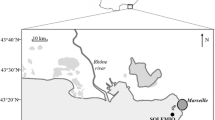Summary
During a neap-spring-neap tidal cycle in the Humber estuary concentrations of suspended solids and oxygen depletion were greatest at spring tides. Most bacteria were attached to particles and attached bacteria (counted using epifluorescence microscopy) increased as solids increased. Concentrations of free bacteria however were unrelated to suspended solids. Heterotrophic activities of bacteria per unit volume of water (measured using 14C glucose uptake and Michaelis-Menton kinetics) varied irregularly and were not related to bacterial crops, suspended solids or oxygen depletion. Activity per bacterium however decreased as suspended solids increased.
Similar content being viewed by others
References
Albright, L.J., Wentworth, J.W.: Use of the heterotrophic activity technique as a measure of eutrophication. Environ. Pollut. 5, 59–72 (1973)
British Transport Docks Board: Silt movement in the Humber Estuary. B.T.D.B. Research Station Report No. R 221 (1970)
Daley, R.J., Hobbie, J.E.: Direct counts of aquatic bacteria by a modified epifluorescence technique. Limnol. Oceanogr. 20, 875–882 (1975)
Denman, N.E.: Physical characters of the Humber. In: The Humber Estuary. University of Hull/Humber Advisory Group Joint Symposium (N.V. Jones, ed.). Hull: Department of Zoology, University of Hull 1973
Elliott, J.M.: Some methods for the statistical analysis of samples of benthic invertebrates. Scient. Publs Freshwat. biol. Ass. No. 25, 1–144 (1971)
Fliermans, C.B., Schmidt, E.L.: Fluorescence microscopy: direct detection enumeration and spatial distribution of bacteria in aquatic systems. Arch. Hydrobiol. 76, 33–42 (1975)
Gocke, K.: Studies on short-term variations of heterotrophic activity in the Kiel Fjord. Mar. Biol. 33, 49–55 (1975)
Harrison, M.J., Wright, R.T., Morita, R.Y.: Method for measuring mineralization in lake sediments. Appl. Microbiol. 21, 698–702 (1971)
Hobbie, J.E.: Heterotrophic bacteria in aquatic ecosystems; some results of studies with organic radioisotopes. Res. Div. Monogr. Va Polytech. Inst. St. Univ. 3, 181–194 (1971)
Jannasch, H.W.: Studies of planktonic bacteria by means of a direct membrane filter method. J. gen. Microbiol. 18, 609–620 (1958)
Jannasch, H.W., Pritchard, P.H.: The role of inert particulate matter in the activity of aquatic microorganisms. Mem. Ist. Ital. Idrobiol., Suppl. 29, 289–308 (1972)
Jones, J.G.: Some observations on direct counts of freshwater bacteria obtained with a fluorescence microscope. Limnol. Oceanogr. 19, 540–543 (1974)
Jones, J.G., Simon, B.M.: An investigation of errors in direct counts of aquatic bacteria by epifluorescence microscopy, with reference to a new method for dyeing membrane filters. J. appl. Bact. 39, 317–329 (1975)
Mackereth, F.J.H.: An improved galvanic cell for determination of oxygen concentrations in fluids. J. sci. Instrum. 41, 38–41 (1964)
Morgan, K.C., Kalff, J.: Bacterial dynamics in two high-arctic lakes. Freshwat. Biol. 2, 217–228 (1972)
Paerl, H.W.: Bacterial uptake of dissolved organic matter in relation to detrital aggregation in marine and freshwater systems. Limnol. Oceanogr. 19, 966–972 (1974)
Paerl, H.W.: Microbial attachment to particles in marine and freshwater ecosystems. Microbial Ecol. 2, 73–83 (1975)
Porter, E.: Pollution in four industrialised estuaries. London: H.M.S.O. 1973
Ramsay, A.J.: The use of autoradiography to determine the proportion of bacteria metabolizing in an aquatic habitat. J. gen. Microbiol. 80, 363–373 (1974)
Royal Commission on Environmental Pollution: Third report: pollution in some British estuaries and coastal waters, Cmnd 5054. London: H.M.S.O. 1972
Seki, H.: The role of microorganisms in the marine food chain with reference to organic aggregates. Mem. Ist. Ital. Idrobiol., Suppl. 29, 245–259 (1972)
Sokal, R.R., Rohlf, F.J.: Biometry. San Francisco: Freeman 1969
Urquhart, C., Dunlop, H.M., Squire, G.M.: Water quality investigations in the Humber and the tidal rivers of Yorkshire. In: The Humber Estuary. University of Hull/Humber Advisory Group Joint Symposium (N.V. Jones, ed.). Hull: Department of Zoology, University of Hull 1973
Wright, R.T., Hobbie, J.E.: Use of glucose and acetate by bacteria and algae in aquatic ecosystems. Ecology 47, 447–464 (1966)
Author information
Authors and Affiliations
Rights and permissions
About this article
Cite this article
Goulder, R. Relationships between suspended solids and standing crops and activities of bacteria in an estuary during a neap-spring-neap tidal cycle. Oecologia 24, 83–90 (1976). https://doi.org/10.1007/BF00545489
Received:
Issue Date:
DOI: https://doi.org/10.1007/BF00545489




